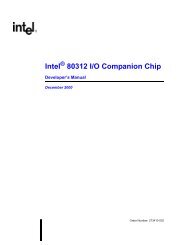Wireless Intel SpeedStep Power Manager
Wireless Intel SpeedStep Power Manager
Wireless Intel SpeedStep Power Manager
Create successful ePaper yourself
Turn your PDF publications into a flip-book with our unique Google optimized e-Paper software.
<strong>Wireless</strong> <strong>Intel</strong> <strong>SpeedStep</strong> ® <strong>Power</strong> <strong>Manager</strong>White Paper■■■■Frequency/Voltage Change, PCFR[FVC]—If the FVC bitis set, a frequency change sequence (DFM) also triggers avoltage change sequence (DVM).Read Pointer, PVCR[RP]—The read pointer field in thePVCR points to the PCMD register location that contains acommand or the first command of multiple commands thatare to be sent to the external regulator via the PWR_I 2 C. Thecommand sequence can start from any one of 32 PCMDregisters. After a command is sent out, the Read Pointerincrements to point to the next PCMD register location. Theread pointer is not incremented if the current command is thelast command, as indicated by PCMD[LC] set.Delay Command Execution, PCMD[DCE]—If the DCE bitis set in the current PCMD, a counter (set by the commanddelay bits in PVCR) waits for a programmable number of13-MHz processor-oscillator cycles before continuingexecution of the command. This is useful if a longer periodbetween commands is required.Multi-Byte Command, PCMD[MBC]—If the MBC bit isset, the voltage change sequencer continues sending byteswith no delay or handshaking with the power manager unituntil a command with the MBC bit clear is executed.■Last Command, PCMD[LC]—If the LC bit is clear, thevoltage-change sequencer expects the PCMD register at thenext higher address to contain an additional command. If theLC bit is clear in PCMD31, the PVCR Read Pointer rolls overto PCMD0 after executing the command in PCMD31. Whenthe LC bit is set, the Voltage Change Sequencer considersthe current command to be the last one and finishes afterexecution completes. Each voltage change commandsequence must be terminated by setting the LC bit of thelast command in the sequence. The PVCR Read Pointer isnot incremented if the LC bit is set.4.4.3 COUPLING VOLTAGE CHANGEWITH FREQUENCY CHANGEA frequency change (clock source change or core PLLfrequency change) may be used to change the frequencyof the core, system bus, memory controller, and LCD controllerto a value not available with turbo or fast-bus modes. Thisfrequency change can be coupled with a voltage change bysetting PCFR[FVC]. Similarly, a voltage change can be coupledwith a change to or from fast-bus mode.4.5 Programmable Operating FrequenciesThe <strong>Intel</strong> PXA27x processor’s programmable operatingfrequencies are shown in Table 1.Core RunFrequencyCLKCFG[T]Core TurboFrequencyCLKCFG[T]CLKCFG[HT]CCCR[L]CCCR[2N]System BusCLKCFG[B]CLK_MEM(Memory Controller)CCCR[A]SDCLKSDRAM ClocksMDREFR[KxDB2] ††Synchronous FlashMDREFR[K0DB4]MDREFR[K0DB2]LCD91.0 † 0 — — 0 7 2 45.0 0 91.0 0 45.0 1 22.5 1104.0 0 104.0 1 0 8 2 104.0 1 104.0 1 104.0 0 52.0 0156.0 0 156.0 1 1 8 6 104.0 1 104.0 1 104.0 0 52.0 0104.0 0 312.0 1 0 8 6 104.0 1 104.0 1 104.0 0 52.0 0208.0 0 208.0 1 0 16 2 208.0 1 208.0 1 104.0 1 52.0 1208.0 0 312.0 1 0 16 3 208.0 1 208.0 1 104.0 1 52.0 1208.0 0 416.0 1 0 16 4 208.0 1 208.0 1 104.0 1 52.0 1208.0 0 520.0 1 0 16 5 208.0 1 208.0 1 104.0 1 52.0 1208.0 0 624.0 1 0 16 6 208.0 1 208.0 1 104.0 1 52.0 11 91.01 52.01 52.01 52.0X 104.0X 104.0X 104.0X 104.0X 104.0† L=7 (Core = 91.0 MHz) must be strictly used as the bootup frequency and immediately reconfigured to one of the other frequency points.†† KxDB2 represents K1DB2 and K2DB2Table 1. Clock Frequencies9
















